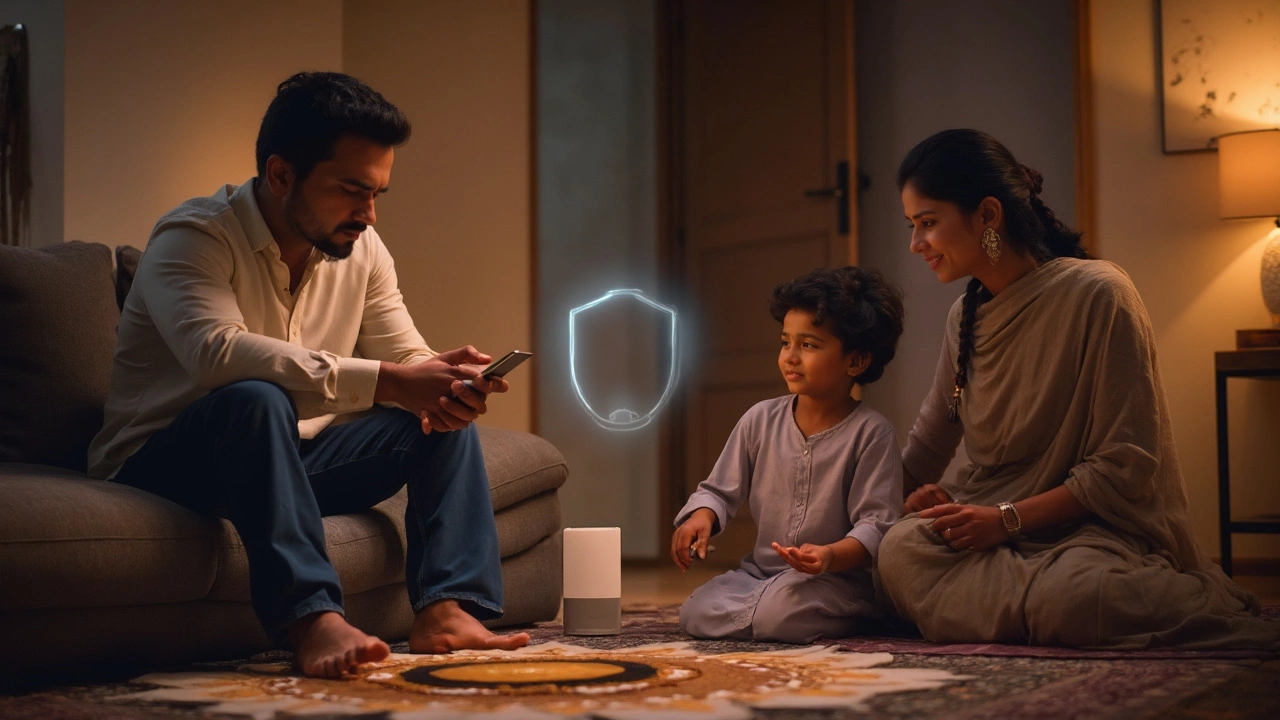
Ever felt like your smart home might be a bit too smart for its own good? With cameras that watch your doorstep, locks you open with your phone, and lights you command with your voice, it feels like living in the future—until you hear about someone’s fridge getting hacked.
Smart gadgets talk to the internet around the clock. That’s handy, but it opens a door for problems. A report from Consumer Reports last fall found that nearly 50% of smart home devices had at least one vulnerability that hackers could target. Doesn’t sound reassuring, right?
Before you start pulling plugs, don’t panic. Most attacks involve devices with weak or default passwords—basically the digital version of leaving your house key under the mat. Changing passwords, running updates, and picking products with clear privacy rules can stop a lot of trouble before it starts. If you’ve already got Alexa, Google Home, or a bunch of smart bulbs, you’re not doomed. It just takes a little extra care to keep your home one step ahead.
- What Makes a Home 'Smart'?
- Biggest Security Risks (And Real-World Examples)
- Protecting Your Smart Home (For Regular Folks)
- Will Smart Homes Ever Be Truly Safe?
What Makes a Home 'Smart'?
A smart home isn’t just about flashy gadgets or showing off the latest tech. At its core, it’s any home where devices are hooked up to your Wi-Fi or hub, so you can control things with your phone, voice, or even automation rules. The big selling point here is convenience—you don’t have to be in the room or even home to adjust things like lights, locks, or security systems. That’s the heart of the smart home safety conversation.
Most smart homes have a mix of these common devices:
- Smart speakers like Amazon Echo or Google Nest for voice commands and streaming
- Smart lights and plugs you can set on schedules or turn on from anywhere
- Smart locks you can control with your phone or codes—goodbye, spare keys
- Security cameras for front doors, driveways, or inside the house
- Thermostats that learn your routine and save on energy bills
Here’s a quick comparison to show how common smart gadgets have gotten in the U.S.:
| Device Type | % of U.S. Homes (2024) |
|---|---|
| Smart Speakers | 55% |
| Smart TVs | 70% |
| Smart Security Cameras | 42% |
| Smart Thermostats | 27% |
Most of these devices connect to an app, cloud account, or even voice assistant. The more stuff you connect, the more control you have—and, of course, the bigger the security puzzle. That’s why people worry about how safe all this really is. You get fancy features and peace of mind, but if it’s not set up right, you could be letting risk walk right through the digital front door.
Biggest Security Risks (And Real-World Examples)
When it comes to smart home safety, the biggest risks are often the ones you never see coming. Hackers aren't breaking in through windows—they're getting in through weak passwords, outdated software, and devices that ship with lousy security settings.
Here's where homes usually get tripped up:
- Default Passwords: Tons of smart gadgets come with the same default password, and most people never change it. In 2016, the massive "Mirai" botnet attack took over thousands of devices—like cameras and routers—using default logins. This attack took down websites like Twitter and Netflix for hours.
- Unpatched Software: Updates can be a pain, but skipping them means your gear misses important security fixes. In 2021, Wyze, a popular camera brand, had a major security flaw discovered by researchers—yet some users were exposed for months because they didn't update their devices.
- Rushed Devices: Cheap smart plugs, bulbs, and cameras are everywhere. Unfortunately, many are made by companies that don’t put enough effort into security. Security company F-Secure found that some budget gadgets could be hijacked in less than five minutes.
- Weak WiFi Protection: If someone cracks your WiFi password, they have a foot in the door to snoop on all your smart stuff. Public reports show that weak WiFi passwords have let people prank homeowners by playing loud music or changing thermostat settings.
- Data Leaks: It’s not just hackers; sometimes companies mess up too. In 2019, Ring doorbells had a privacy scare when it turned out some employees could easily watch customer video feeds.
Check out some quick numbers that bring these risks home:
| Problem | Year | Impact |
|---|---|---|
| Mirai botnet (default passwords) | 2016 | 500,000+ devices hit; websites taken offline |
| Wyze security flaw | 2021 | Millions of cameras affected globally |
| Ring privacy leak | 2019 | Employees accessed user video |
It sounds scary, but for most folks, these attacks only work when basic steps are ignored. The good news is you don’t need to be a tech whiz to block the most common tricks. It’s about knowing where the cracks are and closing them fast.

Protecting Your Smart Home (For Regular Folks)
Keeping a smart home safety game strong isn’t just for the tech pros. Anyone can do it, as long as you cover a few basic steps. Most hacks don’t involve Hollywood-style tricks—they usually happen because someone left their device wide open with things like "admin/admin" as the password.
Here’s what you can do without a computer science degree:
- Change default passwords: Seriously, don’t use "1234" or "password" for anything connected to your Wi-Fi. Make it unique. If the device offers two-factor authentication, switch that on too.
- Update devices: Every time your phone or Alexa says there’s an update, do it. Those security updates are meant to patch holes hackers found. According to a Statista survey in early 2024, only 40% of users kept their smart gadgets updated—don’t be in the 60% left exposed!
- Secure your Wi-Fi: Change your router password to something strong (again, skip "password"). Use WPA3 security if you can, or at least WPA2. Make a guest network for visitors and keep your smart stuff on a separate network if that’s an option.
- Check privacy settings: Many smart speakers and cameras let you mute microphones, turn off data sharing, or limit recording times. Dive into those settings and pick the most private options you can.
If you’re curious about which devices are good (or risky), it helps to check devices for security certifications. Look for things like UL 2900 (a legit cybersecurity mark) or the new Matter badge, showing the device meets security standards from a bunch of big tech companies.
If you want to see which habits actually matter, here’s a breakdown from a real study on common mistakes:
| Common Mistake | Percent of Incidents (Source: Tech Safety Review 2023) |
|---|---|
| Weak/default passwords | 46% |
| Outdated device software | 32% |
| Unsecured Wi-Fi | 17% |
| Ignored privacy settings | 5% |
The bottom line: you don’t need to unplug every gadget, just be smarter than the average hacker. A few minutes of setup can save you hours of frustration (and maybe some weird stories about your fridge speaking Italian on its own).
Will Smart Homes Ever Be Truly Safe?
If you’re hoping for a magic bullet that makes every smart home safety problem disappear, it’s just not happening—yet. Even the biggest brands like Amazon, Google, and Apple get hit with security flaws. Just last year, a glitch in popular smart locks let some users unlock their doors using old codes. On top of that, security researchers keep finding holes that let hackers mess with smart lights and cameras in ways no owner expects.
Here’s a breakdown of some facts about smart home security from the past few years:
| Year | Incident / Study | Impact |
|---|---|---|
| 2023 | Consumer Reports Test | 47% of devices had unpatched vulnerabilities |
| 2023 | Smart Lock Exploit | Thousands of locks at risk from reused codes |
| 2024 | European Data Privacy Audit | 20% of devices sending data to third parties without clear consent |
So why is it so hard to keep these devices locked down? For one, companies rush smart gadgets to market and sometimes skip thorough security checks. Also, updates for older devices often get dropped, letting hackers use old tricks long after you think you’re safe. Some gadgets (like smart baby monitors) still ship with passwords like "admin" or "1234" baked in—hackers actually search for those to break in!
But that doesn’t mean it’s hopeless. Companies are getting better about patching holes once they’re found, and privacy laws like Europe’s GDPR are pushing brands to be more upfront about what they collect. Plus, new tech like two-factor authentication and encrypted connections is popping up in more devices every year.
Realistically, “truly safe” probably means making break-ins so tough and time-consuming that most hackers move on for easier targets. Here’s what actually helps most:
- Always change default passwords to something unique and tough to guess
- Keep every device’s software updated—set alerts or auto-update if possible
- Stick with brands that offer security support and clear privacy rules
- Turn off unused features (especially remote access) unless you really need them
- Use multi-factor authentication whenever it pops up as an option
Tech won’t ever be perfect—as long as people use smart homes, someone will try to break in digitally. The goal is to make your place a hard target so attackers look for an easier score somewhere else. If you keep up with those basics, your odds look a lot better than most.